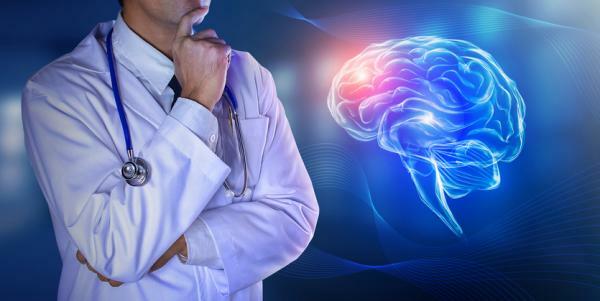
Have you ever had the feeling of living in a dream? If the way you perceive the world is the same in dreams, that is, you see it somewhat distorted and distant, you may have experienced a dissociative disorder. In these cases, you may even perceive yourself in a different way and feel that it is not you. You may not feel the same physically, not because you have gained or lost weight, but because you perceive yourself differently or see yourself from outside your body as someone strange.
Dissociative disorders cause this type of symptomatology that does not allow you to identify with yourself or with what surrounds you. If you want to know more about this type of psychological alterations, in this Psychology-Online article we will talk about the dissociative disorders: what they are, symptoms, causes and treatment.
Index
- What are dissociative disorders
- Symptoms of dissociative disorders
- Causes of dissociative disorders
- Treatment of dissociative disorders
What are dissociative disorders.
According to Spiegel (1991), dissociation is the structured separation of mental processes, such as thoughts, memory or identity, that are normally integrated. Four years later, in 1995, the APA (American Psychologist Association) defined it as the impaired integrative functions of identity, memory, or consciousness.
Types of dissociative disorders
What are dissociative disorders? Find out below:
- dissociative amnesia: inability to recall important autobiographical information that cannot be explained by disease or brain damage.
- Dissociative identity disorder or multiple personality: presence of two or more identities or personality states that implies a discontinuity of the sense of self.
- Depersonalization/derealization disorder: experiences of distancing from oneself and/or experience of distancing from the environment as long as the sense of reality remains intact. In this article you will find information about the depersonalization disorder: what is it, causes, symptoms and treatment.
- Other specified dissociative disorder: identity alteration due to prolonged coercive persuasion or "brainwashing", reactions acute dissociative reactions to traumatic events (transient) or loss of awareness of the immediate environment (trance dissociative).
- Dissociative disorder not otherwise specified: any alteration with forms of pathological dissociation other than those mentioned above.
Symptoms of dissociative disorders.
The symptoms of dissociative disorders it is very diverse. People who experience pathological dissociations may have the following symptoms:
- Spontaneous intrusions into consciousness and behavior.
- Identity fragmentation.
- Depersonalization.
- Derealization.
- Inability to access information or control mental functions that are normally easily accessible or controllable.
- Amnesia.

Causes of dissociative disorders.
There is no known clear cause of dissociative disorders, that is, there is no specific and clear etiology Explain the symptoms they cause. Still, traumatic disorders have typically been associated with the presence of traumatic stressors and are also identified as a symptom of other serious disorders.
The precipitating factor par excellence, and which has seemed to be the common factor in various studies, is the experience of a traumatic event or accumulated stressful vital moments. However, some theories have been developed that could explain the symptoms of dissociative disorders. We see them below:
- Neodissociative Theory (Hilgard, 1977): This theory explains the disorder based on consciousness and executive control. Hilgard says that a divided consciousness is produced by the intervention, in certain circumstances, of the executive control, thus disrupting the integration and hierarchical organization of control structures lower. In short, the connection is broken and there is a decrease in voluntary control.
- Memory theory (Kihlsstroom, 1990): it is stated that a process becomes conscious only if a connection is established between the mental representation of the event and the self as the agent of the event. In that case, if that does not happen, dissociation could appear.
Treatment of dissociative disorders.
The treatment of dissociative disorders is complicated, since it involves the alteration and division of consciousness. Given its nature, the use of hypnosis or similar therapies, since they can cause an effect contrary to the desired one and increase the symptoms. In addition, the treatment of dissociative disorders Varies depending on symptomatology present in the individual and the specific disorder that he manifests.
Even so, in these cases, the basis of treatment is usually psychotherapy supplemented with psychoactive drugs in cases where there is comorbidity with other disorders, that is A quick stabilization is necessary to be able to carry out the first interview and obtain information clear.
To understand it, we will present an example of how to treat dissociative identity disorder in different phases:
- Stabilize symptoms.
- Address traumatic memories that may have given rise to dissociation in multiple personalities.
- Integrate and rehabilitate the different parts of consciousness in which it has been divided.
However, there are authors who appeal for working from the different parts in which it is found. divided consciousness, seeking functionality and optimization of the internal organization of the individual. Ultimately, what the experts agree on is that address the traumatic event that has precipitated the dissociative symptomatology in the patient to reduce it and obtain optimal performance on a daily basis.

This article is merely informative, in Psychology-Online we do not have the power to make a diagnosis or recommend a treatment. We invite you to go to a psychologist to treat your particular case.
If you want to read more articles similar to Dissociative disorders: what they are, symptoms, causes and treatment, we recommend that you enter our category of Clinical psychology.
References
- American psychiatric association, (2014). Diagnostic and Statistical Manual of Mental Disorders DSM – 5. Madrid Spain. Pan American Medical Publishing.
Bibliography
- Belloch, A., Sandin, B., Ramos, F., (2009). Manual of psychopathology, volume II. Madrid. McGraw Hill / Interamericana de España, S.A.U.
- Rubio, J. C., & Garcia, M. EITHER. (2019). Dissociative disorders. Medicine-Accredited Continuing Medical Education Program, 12(84), 4938-4946.
- Vazquez, A., (2018). TREATMENT OF DISSOCIATIVE DISORDERS. 9th Virtual Congress of Psychiatry. Interpsyche.
Dissociative disorders: what they are, symptoms, causes and treatment


